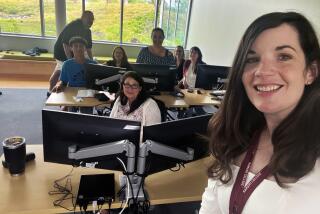UC Irvine Scientist Professor to Test Bones in Santo Domingo : Search for Columbus’ Remains Nears Climax
Where are the final remains of Christopher Columbus?
Are they in Spain, Italy, Cuba or the Dominican Republic?
With seven years remaining before a global celebration of the 500th anniversary of the discovery of America, the historical mystery is of political significance, said Prof. Jonathon Ericson of the University of California, Irvine. He hopes to solve the riddle this summer, using atomic tracing on bones and teeth believed to be those of Columbus.
“It’s a geopolitical issue,” Ericson said. “The countries involved are Third World nations. To them, the importance of having the remains of Christopher Columbus is similar to the importance of the Olympics to Los Angeles.
“The whole world will be interested in this in 1992. Every country will be marking the 500th anniversary (of America’s discovery). It’s believed, for instance, that Russia will try to establish a lunar colony that year.”
Ericson, 42, a professor of social ecology, has already had a role in historical sleuthing. He was one of the American scientists who helped Peruvian authorities determine the real remains of South American conquistador Francisco Pizarro.
“With Pizarro, the issue was simpler,” Ericson said. “The remains were somewhere in the cathedral (at Lima). But with Columbus, there have been so many moves (of the remains) that several countries are involved.”
Columbus’ exact birthday is unknown, but history agrees on the date of his death: May 20, 1506, in Valladolid, Spain. His body was interred in that city but was removed in 1509. Ericson said the second interment was in Triana, Spain, but the Encyclopedia Americana says the second burial was in Seville, Spain.
In 1541, the remains again were disinterred and shipped to Santo Domingo, in what is now the Dominican Republic. The city is on the island that Columbus discovered on his first voyage.
Some historians claim that the explorer’s body still rests in the cathedral at Santo Domingo, together with the remains of his eldest son, Diego, who was viceroy of the island after his father’s death.
But Ericson has noted that during excavations at the cathedral in Santo Domingo in 1795, human bones and ashes were found next to the high altar. The remains were presumed to be those of Christopher Columbus, Ericson said, and early in the 19th Century, Spanish authorities shipped the remains to Havana. Later still, the remains in Havana were moved to the Cathedral of Seville, he said.
Ericson added that there was yet another reported, but unsubstantiated, disinterment. “There is some belief that the Genovese (people of Genoa, Italy) brought the body back to that city from Seville,” Ericson said. The unsubstantiated report claims that the explorer’s body was brought back to Genoa early in the 20th Century, he said.
“One priest I have talked with, and who’s an authority on the subject, has jokingly said that Columbus moved more in death than he did in life,” Ericson said. The joke is not based on truth, Ericson noted, even if Columbus’ remains were moved as often and to as many places as some authorities claim. Columbus, in life, crossed the Atlantic four times on voyages to the New World, and before that he had sailed to Ireland and Iceland on earlier voyages.
Despite the claim that Columbus’ remains were moved from Santo Domingo, Ericson believes that a mistake was made and that someone else’s bones were moved to Havana in the early 1800s. He said that in 1877, a small lead casket was found in the cathedral of Santo Domingo. The casket contained the initials CCA, possibly standing for the Spanish abbreviation for “Christopher Columbus, Admiral.”
It is those remains in Santo Domingo that will be tested this summer, Ericson said. If the testing proves negative, the professor added, the search will then turn to the other reputed resting places of Columbus.
“At any point in the movements (of the remains), there could have been an error,” Ericson said. He added that the wrong body accidentally or deliberately (such as for political reasons) could have been disinterred anywhere along the line.
Ericson said his proposed proof will be by using “strontium isotope characterization.” Strontium, he noted, is an element that enters food, and thus human bodies, in small but lasting amounts. Ericson said that the atomic forms of strontium--the isotopes--vary according to the geography of where the element existed at the time it entered food products.
Thus, he said, he will go to Genoa this June to learn the isotopic composition of strontium in the plants, animals and soils around that city, where Columbus was born and grew up.
Ericson will then test the “CCA” remains that are in Santo Domingo. If the isotopes of strontium are the same, he said, the proof will have been established.
More to Read
Sign up for Essential California
The most important California stories and recommendations in your inbox every morning.
You may occasionally receive promotional content from the Los Angeles Times.










